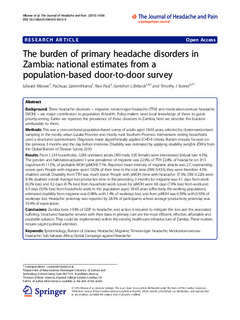| dc.contributor.author | Mbewe, Edward | |
| dc.contributor.author | Zairemthiama, Pachuau | |
| dc.contributor.author | Paul, Ravi | |
| dc.contributor.author | Birbeck, Gretchen | |
| dc.contributor.author | Steiner, Timothy J. | |
| dc.date.accessioned | 2019-11-13T10:04:55Z | |
| dc.date.available | 2019-11-13T10:04:55Z | |
| dc.date.created | 2015-06-30T10:01:43Z | |
| dc.date.issued | 2015 | |
| dc.identifier.citation | The Journal of Headache and Pain. 2015, 16 (1), . | nb_NO |
| dc.identifier.issn | 1129-2369 | |
| dc.identifier.uri | http://hdl.handle.net/11250/2628107 | |
| dc.description.abstract | Background
Three headache disorders – migraine, tension-type headache (TTH) and medication-overuse headache (MOH) – are major contributors to population ill-health. Policy-makers need local knowledge of these to guide priority-setting. Earlier we reported the prevalence of these disorders in Zambia; here we describe the burdens attributable to them.
Methods
This was a cross-sectional population-based survey of adults aged 18-65 years, selected by cluster-randomized sampling in the mostly urban Lusaka Province and mostly rural Southern Province. Interviewers visiting households used a structured questionnaire. Diagnoses made algorithmically applied ICHD-II criteria. Burden enquiry focused on the previous 3 months and the day before interview. Disability was estimated by applying disability weights (DWs) from the Global Burden of Disease Survey 2010.
Results
From 1,134 households, 1,085 unrelated adults (450 male, 635 female) were interviewed (refusal rate 4.3%). The gender- and habitation-adjusted 1-year prevalence of migraine was 22.9%, of TTH 22.8%, of headache on ≥15 days/month 11.5%, of probable MOH (pMOH) 7.1%. Reported mean intensity of migraine attacks was 2.7, representing severe pain. People with migraine spent 10.0% of their time in the ictal state (DW: 0.433); they were therefore 4.3% disabled overall. Disability from TTH was much lower. People with pMOH (time with headache: 37.5%; DW: 0.220) were 8.3% disabled overall. Average lost productive time in the preceding 3 months for migraine was 4.1 days from work (6.3% loss) and 4.2 days (4.7% loss) from household work. Losses for pMOH were 4.8 days (7.4% loss) from work and 4.5 days (5.0% loss) from household work. In the population aged 18-65 years (effectively the working population), estimated disability from migraine was 0.98%, with 1.4% of workdays lost, and from pMOH was 0.59%, with 0.53% of workdays lost. Headache yesterday was reported by 28.3% of participants, whose average productivity yesterday was 55.9% of expectation.
Conclusions
Zambia loses 1.93% of GDP to headache, and action is required to mitigate this loss and the associated suffering. Structured headache services with their basis in primary care are the most efficient, effective, affordable and equitable solution. They could be implemented within the existing health-care infrastructure of Zambia. These matters require urgent political attention. | nb_NO |
| dc.language.iso | eng | nb_NO |
| dc.publisher | BMC (part of Springer Nature) | nb_NO |
| dc.rights | Navngivelse 4.0 Internasjonal | * |
| dc.rights.uri | http://creativecommons.org/licenses/by/4.0/deed.no | * |
| dc.title | The burden of primary headache disorders in Zambia: national estimates from a population-based door-to-door survey | nb_NO |
| dc.type | Journal article | nb_NO |
| dc.type | Peer reviewed | nb_NO |
| dc.description.version | publishedVersion | nb_NO |
| dc.source.pagenumber | 8 | nb_NO |
| dc.source.volume | 16 | nb_NO |
| dc.source.journal | The Journal of Headache and Pain | nb_NO |
| dc.source.issue | 1 | nb_NO |
| dc.identifier.doi | 10.1186/s10194-015-0513-9 | |
| dc.identifier.cristin | 1251531 | |
| dc.description.localcode | © 2015 Mbewe et al.; licensee Springer. This is an Open Access article distributed under the terms of the Creative Commons Attribution License (http://creativecommons.org/licenses/by/4.0), which permits unrestricted use, distribution, and reproduction in any medium, provided the original work is properly credited. | nb_NO |
| cristin.unitcode | 194,65,30,0 | |
| cristin.unitname | Institutt for nevromedisin og bevegelsesvitenskap | |
| cristin.ispublished | true | |
| cristin.fulltext | original | |
| cristin.qualitycode | 1 | |

